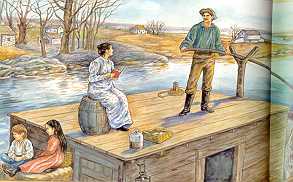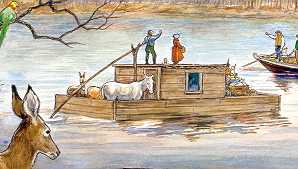
When I was a small boy, my father told me several times that "some of
our ancestors came down the Ohio by flatboat". I don't remember any of
the details of that story, and I'm not sure Dad even knew which ancestors
they were, or from where they had come. Perhaps this was a story he
remembered his grandmother telling him when he was a small boy.
Since she died when Dad was only seven years old, he could have heard
the story from other family members.

After I started researching my family's history, I read the biographies and obituaries of some of these Perry kinsmen and learned that their family had indeed migrated from Venango county, PA, down the Ohio River to Gallia county, OH, in the 1840s, moving on to Miami county by 1850, then again to Urbana, in Champaign county, around the time of the Civil War. After making contact with a number of my cousins who are descended from great grandmother's brothers and sisters, I learned more about the journey made by this family. I'll try to put together the details of their voyage down the river here for all of us. If you can contribute anything to the story, please drop me a line. The travelers included:
 The Allegheny River flows through Venango county,
on its way south to Pittsburgh, PA, where it joins the Monongahela to
form the Ohio. During the early 19th century, the Allegheny was used for
floating timber to market in Pittsburgh, and was also a waterway which
connected communities in western Pennsylvania. Between
April 13-29, 1996, a 19th century river expedition was recreated aboard the
Venango Museum of
Art, Science, and Industry's working replica of the packet boat "Pine
Knot," which carried a volunteer crew and performers in period dress to
thirteen riverbend communities along the Allegheny.
The Allegheny River flows through Venango county,
on its way south to Pittsburgh, PA, where it joins the Monongahela to
form the Ohio. During the early 19th century, the Allegheny was used for
floating timber to market in Pittsburgh, and was also a waterway which
connected communities in western Pennsylvania. Between
April 13-29, 1996, a 19th century river expedition was recreated aboard the
Venango Museum of
Art, Science, and Industry's working replica of the packet boat "Pine
Knot," which carried a volunteer crew and performers in period dress to
thirteen riverbend communities along the Allegheny.
 The Perry family built their shallow draft boat on their property
which lay along a creek that flowed into the Allegheny and set out for Ohio
along with one other family. Their journey would have begun after the last
thaw of winter, when their creek and the rivers it fed into were
in their highest, most navigable, state. Tragedy struck in Pittsburgh
when the boat hit a pier and one of the members of the other family
fell in the river and drowned.
The Perry family built their shallow draft boat on their property
which lay along a creek that flowed into the Allegheny and set out for Ohio
along with one other family. Their journey would have begun after the last
thaw of winter, when their creek and the rivers it fed into were
in their highest, most navigable, state. Tragedy struck in Pittsburgh
when the boat hit a pier and one of the members of the other family
fell in the river and drowned.
James Perry later told his grandson, Walter Scott, about making the move when he was six years old.3 He recalled the tragic accident and also how one of the men gave him some chewing tobacco which he spat in the Ohio River.
I'm indebted to Walter and his wife, Nancy, for providing these descriptions of the 19th Century flatboating experience...
Steering a flatboat was attempted by the gouger, the thirty or forty foot rear oar, and the two (sometimes four) side horns. The three long oars, or sweeps, were made by fastening a board to the end of a long pole. The rear oar was pivoted in a forked stick fastened to the roof or a rear porthole. For any success at keeping the flatboat in the current two men (or women or children) had to work each side oar.
Scotch Fiddle was a euphemism for the itch that afflicted most flatboaters.
Perils included current, drowning, falls, fog, flood, Harpes (pirates), ice, incompetent captains, Indians, malaria, yellow fever and cholera, other boatmen, planters, sawyers, sleepers (submerged snags), Plugs (pirates who would come on board as innocents and work the caulk from between the boards to start the boat sinking, only to steer it to shore for "repairs" and capture), rocks, shoals, sunken boats, overhanging trees, unscrupulous boat builders, ripples, wind and storms, and general exhaustion.4
Mr. McClure balanced on the cabin roof and steered with a long, sweeping oar. Mrs. McClure read aloud from The Navigator, a book of advice for travelers on the Ohio. The horse, the cow, the mule, and the pig rode behind the cabin, munching corn, thumping the deck. The children rode up front with the wagon and plow, among barrels, bundles, and tools... Their job was to watch for sandbars and snags, and to give a holler if they saw danger ahead... If they met a steamboat chugging upriver, or a keelboat gliding along with its crew of grunting men, Mary blew hard on the tin horn, and Jonathan yelled, "Flatboat coming!" Every afternoon at sunset, the McClures tied up on the bank, along with four or five other boats. The children pulled in trotlines to see what fish they had caught, and they gathered driftwood for fires. They refilled water barrels from the river, but let the mud settle out before drinking. The mothers traded food and lantern oil and stories. The fathers hunted deer and turkey for supper, then took turns all night standing guard.5
It's hard to measure distance precisely along these winding rivers, but it seems obvious that the voyage from the Perrys' property in Venango county to Gallipolis covered at least 300 miles and may have taken them several weeks. Did they select Gallia county as their destination in advance? Did it look like a good place to make their new home? Was the imminent birth of Phebe Ann a factor? Or did problems develop with their boat which kept them from continuing? Why did they move on to Miami county, well over 100 miles to the northwest as the crow flies, after only three years or so? These are all questions which have occurred to us for which we don't have any answers at the moment.
During their stay in Gallia county, two more children were born to John and Mary Ann and appeared with them on the 1850 census in Miami county6:
From Gallia county, the Perrys moved on to Piqua, in Miami county, in time for the 1850 census. John and Mary Ann Perry are listed on several deeds recorded in Piqua during the 1850s. While in Piqua, two more children were born:
1 This marriage date and the children's birth
dates are taken from a very old handwritten copy of John and Mary Ann's
family Bible pages which is in Walter and Nancy Scott's possession.
They have sent me copies of their copy. While some information was
illegible, the birth dates are all very easy to read. My only question
would be whether the information was correctly transcribed from the
original Bible, which was lost in a fire at the home of a descendant.
In an affidavit relating to James Perry's veteran's pension application,
it was stated that the Bible was purchased in Pittsburgh, PA, in 1844.
Does this imply that the Perry flatboat journey took place in that year,
or was the 1844 trip to Pittsburgh separate from the river voyage?
2 This is the birth date which I had for Samuel in my
own family history files. A date of 12 May 1836 was given to
me by his granddaughter, Virginia (Perry) Culbert, and also
appears in his obituary. If David's birth date is correct, the 1836
date for Samuel seems too late to be accurate.
3 James didn't turn six until 20 Oct 1845, two months
after Phebe's birth, and apparently after the family's arrival in
southern Ohio. He may have meant that the trip took place when he
was "almost six years old".
4 From A Flatboat Hornbook by Gail King in Owen
County History & Genealogy, Vol. 8 No. 1, Winter 1999, p. 16.
5From The Floating House by Scott Russell Sanders,
illus. Henen Cogancherry, Macmillan, NY 1995, which is also the source of
the second and third illustrations. (The source of the first drawing is
unknown.)
6 John Perry & Mary Ann & 7 children, 1850 census, Miami
County, Washington Twp, OH. Reel 711 759/381A unnumbered before 761/382.
Allen Co (Ft Wayne IN) Lib.
7 Since all censuses list Phoebe's birthplace as Ohio, this suggests that the Perrys' river journey occurred in 1845 at the latest. But do I have a correct date of birth for her? The 1850, 1860 and 1870 censuses list her as 5, 14 and 23 years old, respectively! She is listed as 31 years old in the 1880 census, which would hint at an 1848 birth date, and as 40 years old in her 1887 obituary, which would suggest 1846.
This page was last updated 18 Feb 2005.